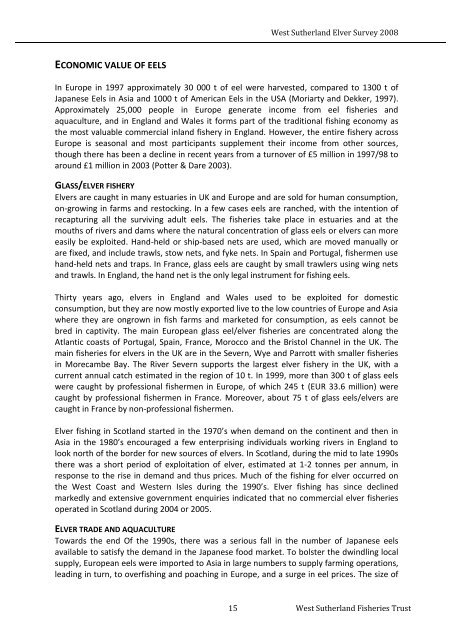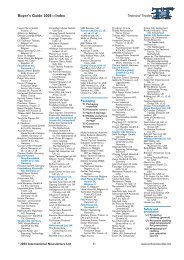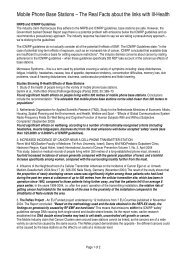West Sutherland Elver Survey
West Sutherland Elver Survey
West Sutherland Elver Survey
You also want an ePaper? Increase the reach of your titles
YUMPU automatically turns print PDFs into web optimized ePapers that Google loves.
ECONOMIC VALUE OF EELS<br />
<strong>West</strong> <strong>Sutherland</strong> <strong>Elver</strong> <strong>Survey</strong> 2008<br />
In Europe in 1997 approximately 30 000 t of eel were harvested, compared to 1300 t of<br />
Japanese Eels in Asia and 1000 t of American Eels in the USA (Moriarty and Dekker, 1997).<br />
Approximately 25,000 people in Europe generate income from eel fisheries and<br />
aquaculture, and in England and Wales it forms part of the traditional fishing economy as<br />
the most valuable commercial inland fishery in England. However, the entire fishery across<br />
Europe is seasonal and most participants supplement their income from other sources,<br />
though there has been a decline in recent years from a turnover of £5 million in 1997/98 to<br />
around £1 million in 2003 (Potter & Dare 2003).<br />
GLASS/ELVER FISHERY<br />
<strong>Elver</strong>s are caught in many estuaries in UK and Europe and are sold for human consumption,<br />
on-growing in farms and restocking. In a few cases eels are ranched, with the intention of<br />
recapturing all the surviving adult eels. The fisheries take place in estuaries and at the<br />
mouths of rivers and dams where the natural concentration of glass eels or elvers can more<br />
easily be exploited. Hand-held or ship-based nets are used, which are moved manually or<br />
are fixed, and include trawls, stow nets, and fyke nets. In Spain and Portugal, fishermen use<br />
hand-held nets and traps. In France, glass eels are caught by small trawlers using wing nets<br />
and trawls. In England, the hand net is the only legal instrument for fishing eels.<br />
Thirty years ago, elvers in England and Wales used to be exploited for domestic<br />
consumption, but they are now mostly exported live to the low countries of Europe and Asia<br />
where they are ongrown in fish farms and marketed for consumption, as eels cannot be<br />
bred in captivity. The main European glass eel/elver fisheries are concentrated along the<br />
Atlantic coasts of Portugal, Spain, France, Morocco and the Bristol Channel in the UK. The<br />
main fisheries for elvers in the UK are in the Severn, Wye and Parrott with smaller fisheries<br />
in Morecambe Bay. The River Severn supports the largest elver fishery in the UK, with a<br />
current annual catch estimated in the region of 10 t. In 1999, more than 300 t of glass eels<br />
were caught by professional fishermen in Europe, of which 245 t (EUR 33.6 million) were<br />
caught by professional fishermen in France. Moreover, about 75 t of glass eels/elvers are<br />
caught in France by non-professional fishermen.<br />
<strong>Elver</strong> fishing in Scotland started in the 1970’s when demand on the continent and then in<br />
Asia in the 1980’s encouraged a few enterprising individuals working rivers in England to<br />
look north of the border for new sources of elvers. In Scotland, during the mid to late 1990s<br />
there was a short period of exploitation of elver, estimated at 1-2 tonnes per annum, in<br />
response to the rise in demand and thus prices. Much of the fishing for elver occurred on<br />
the <strong>West</strong> Coast and <strong>West</strong>ern Isles during the 1990’s. <strong>Elver</strong> fishing has since declined<br />
markedly and extensive government enquiries indicated that no commercial elver fisheries<br />
operated in Scotland during 2004 or 2005.<br />
ELVER TRADE AND AQUACULTURE<br />
Towards the end Of the 1990s, there was a serious fall in the number of Japanese eels<br />
available to satisfy the demand in the Japanese food market. To bolster the dwindling local<br />
supply, European eels were imported to Asia in large numbers to supply farming operations,<br />
leading in turn, to overfishing and poaching in Europe, and a surge in eel prices. The size of<br />
15 <strong>West</strong> <strong>Sutherland</strong> Fisheries Trust











